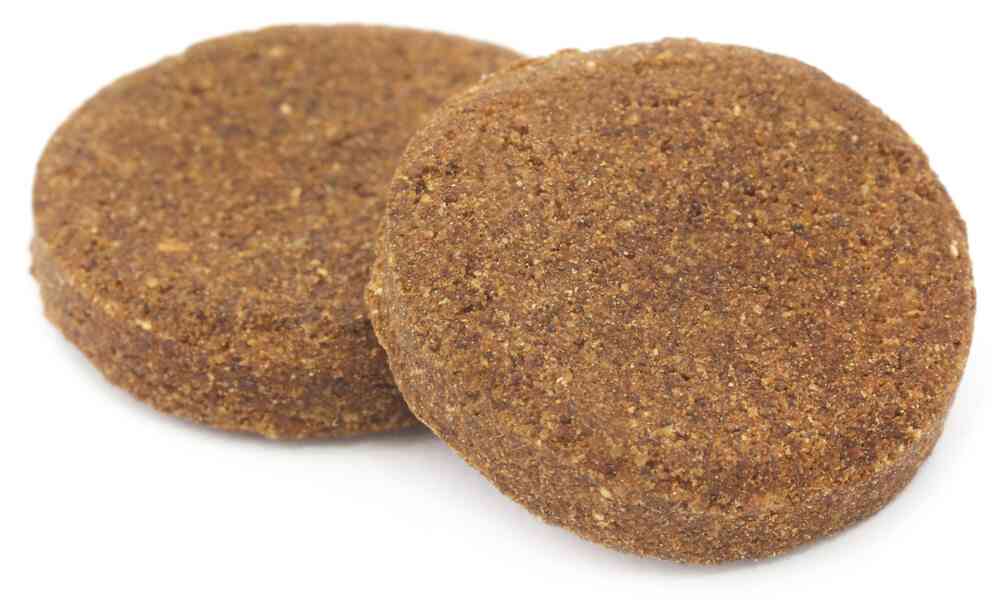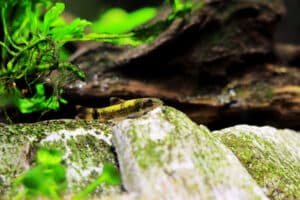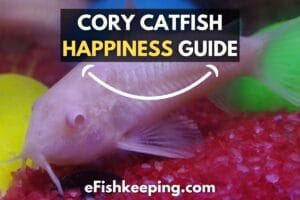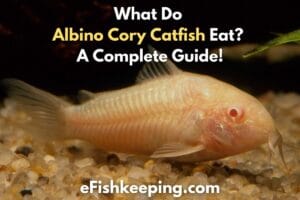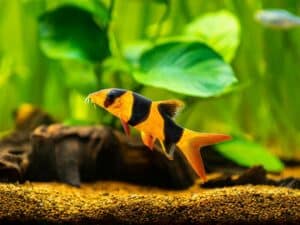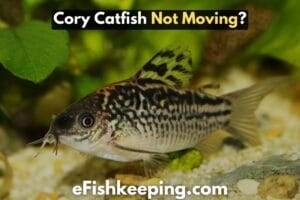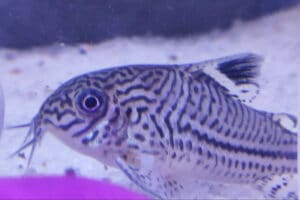When it comes to feeding your Cory Catfish, you may be wondering what types of food they will enjoy. Algae wafers may comcleae to mind as a potential feeding option, but can Cory Catfish eat them? Read on to explore more!
Their Anatomy Is Not Suited For Eating Algae
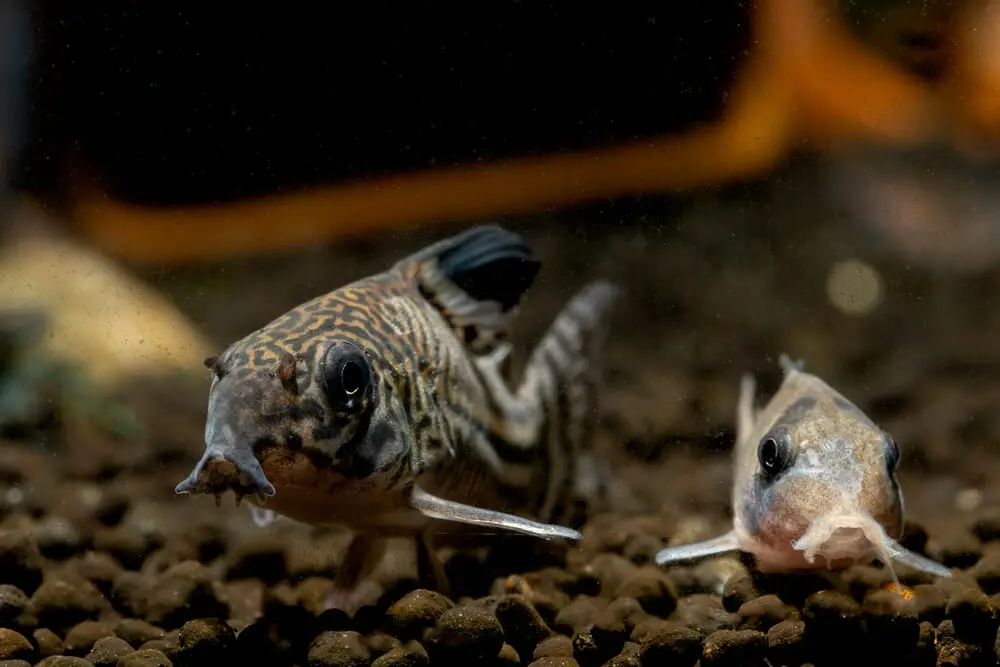
Cory Catfish, like many bottom dwelling fish, have a downward curved mouth that is adapted for finding and eating food scraps from the substrate.
On the other hand algae eaters, such as plecos, have a rasping mouth that acts like a vacuum cleaner and is well-suited for sucking algae from tank surfaces, (this is not the case for Cory Catfish).
Cory catfish are not equipped with a mouth that is capable of effectively removing algae from tank walls or other surfaces. Instead, they are more likely to scavenge for food scraps and other small bits of organic matter that they can find on the bottom of the tank.
Related Guide: Do Cory Catfish Clean The Tank?
But Cory Catfish Love Eating Algae Wafers In Most Cases
In most cases, your cory catfish would love munching on algae wafers and here’s why:
- Algae wafers are a convenient and easy-to-access food source for Cory Catfish. These tasty algae wafers are shaped into convenient discs that can be effortlessly tossed into your tank. And in a short time, they’ll sink to the bottom where your Cory Catfish can easily find it and feed at its ease.
- Cory Catfish are scavengers and foragers by nature, and they may be naturally drawn to the scent and taste of algae wafers. Many hobbyists have reported that their cory catfish just love eating algae wafers.
By the way, do you have albino cory catfish? Then I highly recommend checking out the complete guide on albino cory catfish diet.
And The Good Thing – Algae Wafers Are Nutritious For Them
Algae wafers are a nutritious food for Cory Catfish, as they are made from a blend of ingredients that are designed to provide a balanced diet for them. Algae wafers are rich in protein content in addition to the vegetable content – making it a suitable addition to the Cory Catfish diet.
![Hikari Usa Inc AHK21328 tropical Algae Wafer 8.8-Ounce [2-pk]](https://m.media-amazon.com/images/I/51Ey1+D5AmL._SL300_.jpg)
Here’s a list of some of the ingredients present in one of the popular algae wafer for Cory Catfish (Hikari Tropical Algae Wafer – Link to Amazon)
- Fish Meal
- Dried Seaweed Meal
- Soybean Meal
- Wheat Flour
- Krill Meal
- Spirulina
- Fish Oil
So as you can see, these algae wafers are a dense pack of protein and other necessary ingredients for the fish.
In the wild, Cory Catfish would naturally forage for a variety of plant materials and small invertebrates, which would provide them with a diverse range of nutrients.
Algae wafers can help to mimic this natural diet and provide a convenient source of nutrition for Cory Catfish in an aquarium setting.
Just Don’t Rely On Algae Wafers Alone – Go For A Varied Diet
It is important to remember, however, that while algae wafers can be a good source of nutrition for Cory Catfish, they should not be the only type of food they receive.
By only providing algae wafers, you may not be meeting all of your Cory Catfish’s nutritional needs, which could result in nutrient deficiencies and potentially lead to health problems for your fish.
Secondly, Cory Catfish are scavengers and foragers by nature, and they have a diverse diet in the wild.
By only offering a single type of food, you may not be satisfying their natural foraging instincts and behaviors. This can lead to boredom and decreased overall well-being for your fish.
Read how to keep cory catfish happy in this guide.
Overall, it is important to remember that while algae wafers can be a good source of nutrition for Cory Catfish, they should not be the only type of food they receive. A varied diet is important for the overall health of your fish.
It is important to provide a varied diet that includes other types of food, such as live or frozen brine shrimp and bloodworms, as well as vegetables such as blanched lettuce.
Follow These Tips While Feeding Algae Wafers To Your Cory Catfish
- Dissolve and soak the algae wafers in water beforehand so that Cory catfish can easily feed on them.
- Allow the Corys some time to adjust to the algae wafers – once they become accustomed, they will enjoy foraging for algae wafers whenever you add them to the tank.
- Avoid overfeeding, as excess food can lead to excess algae growth and poor water quality.
- Monitor your Cory Catfish’s appetite and adjust the amount of algae wafers you offer accordingly.
Is It OK If Cory Catfish Don’t Eat Algae Wafers?
While algae wafers can be a helpful supplement to the diet of Cory catfish, they are not essential. Cory catfish are omnivorous, which means that they can survive on a varied diet that includes both plant and animal matter.
If your Cory catfish are not interested in algae wafers, you can provide them with other types of food. Some options include:
- Flakes: Fish flakes are a convenient and widely available option that can provide your Cory catfish with a balanced diet.
- Pellets: Fish pellets are another popular option that can be fed to Cory catfish. They are often made with a variety of ingredients, including plant matter and fish meal, to provide a well-rounded diet.
- Live or frozen foods: Live or frozen foods, such as brine shrimp, daphnia, or bloodworms, can provide your Cory catfish with a nutritious and varied diet.
Wrapping Up
In short, while Cory Catfish may not be able to eat algae directly from the tank, they will consume algae wafers – which is also a nutritious food source for them.
But If your Cory catfish are not interested in algae wafers, don’t worry, there are many other types of food that you can offer them, such as flakes, pellets, or live or frozen foods. With a varied diet and proper care, your Cory catfish can thrive in your home aquarium.
Need More Help With Cory Catfish Keeping? I Highly Recommend Checking Out These Handpicked Guides:
- Cory Catfish Pregnant? A Closer Look At Its Breeding
- Do Cory Catfish Need Bubbler? Do They Like Current?
- Cory Catfish Tank Size: A Complete Guide (+ Infographic)
Hi! I’m Praveen Ghoshal, the founder of eFishkeeping.com. Inspired by my Dad, I got interested in fishkeeping when I was a kid. Since then, I have been involved with this hobby. Currently, I have 3 fish tanks at our home, and I enjoy this hobby with my full family. Read more about me here.

